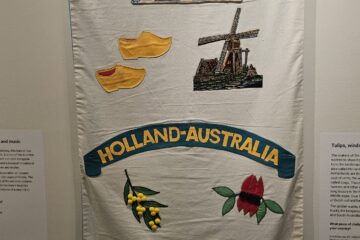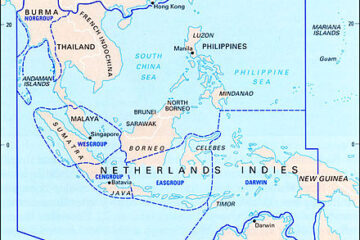This story starts with the famous First Fleet of eleven vessels sailing into Sydney Cove in 1788. The plan was to establish a colony that would become self-sufficient. They brought with them supplies for 2 years for the 1000 people. After they had unloaded their supplies over a period of several months one by one, however, the First Fleet ships sailed away, leaving the two naval vessels, the First Fleet Flagship HMS Sirius and the Royal Navy Tender HMS Supply, to serve and protect the colony.
On a side note, there was also a Dutch sailor on one of the boats. the HMS Friendship (transporting both soldiers and convicts), his name was Cornelius Du Heg. He is most likely the first Dutchman visiting Sydney (Port Jackson).

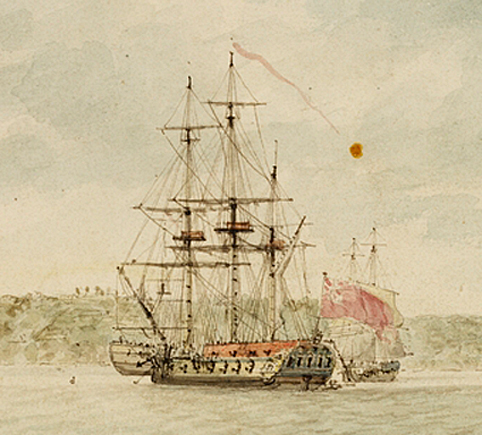
The tiny Royal Navy Tender HMS Supply was starting to wear out. It had been put to sea again in mid-February 1788 to carry a party of officers and convicts to Norfolk Island to start a settlement. Now it was sailing so low in the water that waves were washing over its decks. It would soon be of very little use.
In Sydney, the soil was not very productive for European agriculture and whatever grew was rapidly eaten by the local wildlife. Cattle had escaped and with them the availability of meat disappeared. The soil in Norfolk was much better and they soon had a good functioning agriculture settlement.
With the Supply becoming less operational, the Sirius was therefore used to bring prisoners, settlers and supply to the small colony on the island.
In September 1789 the ‘rescue’ supply ship the Guardian, left London for Sydney – heavily loaded with supplies. Unknown to Governor Phillip, the ship ran into an iceberg in the Southern Ocean. For a year people kept watching out for the ship to arrive in Sydney.
The impending starvation at Sydney led to a great transplantation of 275 people (116 convict men, 67 convict women, 27 children and 65 marines) to Norfolk Island in March 1790 on HMS Sirius. However, while landing stores on the island on 19 March 1790 the ship got wrecked on the reef. This made an already desperate situation worse and it was even considered to abandon Australia all together.
On board was also William Bradley. He was a British naval officer and cartographer who was one of the officers who participated in the First Fleet to Australia. He participated in several journey. He kept a journal and made many painting during his trips.
In April 1790, the Supply returned to Sydney with the devastating news that the Sirius had been wrecked.
In both Sydney and Norfolk Island supplies became extremely low. Governor Phillip mentioned that in Sydney people were wearing rags, and many had no shoes, food was half-rationed. In Norfolk Island the result of the shipwreck was a doubling of the population, without anywhere near sufficient food.
It could be that there were also some convicts with Dutch heritage who experienced these testing time in the new penal colonies of Sydney and Norfolk Island.
Their only hope for longer term survival lay with the little brig, the Supply, now leaky and worn out. Supply was to make a run for the closest town, Batavia. Captain Henry Lidgbird Ball was authorised, while picking up supplies to charter a Dutch vessel to deliver more stores for Sydney. The Supply left on 17 April.
Fortunately the packet boat the Waaksamheyd (Waakzaamheid, Waaksamheyd, Waakzamkeit) – a Dutch 300 ton mercantile medium-sized brig for domestic mail, passenger, and freight transportation – would soon arrive in Batavia and the Dutch authorities ensured Ball that they would made this ship available for the rescue mission.
Lieutenant Philip Gidley King was also onboard of the Supply, he had to go back to England to report on the dire situation of the colony. In Batavia he boarded, in July 1790, the VOC packet boat ‘Snelheid’ (from the Chamber of Hoorn). However, soon after its departure a fever raged under the crew and also Philip became ill. The ship went to the Dutch port at the island of Mauritius. Here the crew and Philip recuperated. The ship continued its journey to the Netherlands via Cape of Good Hope, here Philip changed ship, which took him back to England.
In the meantime, the Supply struggled back to Sydney and arrived there on 18 October, carrying a precious cargo of food. In Batavia, a terrible fever had been raging and several of the Supply’s officers had died there.
Lietenant Newton Fowell described Batavia as an unhealthy town. The reason he indicated was that the many canals are not kept clean and the build up of waste was appalling. None of the men on the Supply had been ill before but now fell ill days after they arrived in Batavia.
The good news however, was that the Waaksamheyd, was due in a few weeks, carrying 171 barrels of beef, 172 barrels of pork, seventy thousand pounds (that’s almost 32 tonnes) of rice, one thousand pounds (that’s 454 kilos) of sugar and 39 barrels of flour – all bought in Batavia.
Captain Deter Smit of the Waaksamheijd arrived at Port Jackson on 17 December 1790 and was warmly welcomed, ensuring that the fledgling colony survived.
On the way back, Captain John Hunter of the Sirius was transported back to England on board the Waaksamheijd and faced a court martial over the loss of HMS Sirius (but was acquitted). The ship left Port Jackson on 27 March 1791 with 125 men on board. Also onboard was also Abel Seaman George Raper who took his paint box with him, containing a larger set of paints than that of his captain John Hunter, who was also an artist. He painted the ship in Mindanao (see below). While seeking provisions on Mindanao, the shore party was attacked by natives, without any loss.
Also onboard was the earlier mentioned William Bradley.
The ship finally arrived at Portsmouth on 8 April 1792.
The following is from William Bradley – Journal titled `A Voyage to New South Wales’, December 1786 – May 1792; compiled 1802+
Friday. 27th April: A Court Martial was held on board of the Brunswick to try Capt. Hunter, the Officers & Crew of the Sirius for the loss of the said Ship; when it appear’d that every thing was done, that could be done; to save the Ship; Capt. Hunter, the Officers & Crew were Honorably Acquitted & removed from the Waakzaamheydt to the Admiral’s Ship, where they were paid off the 4th May 1792 …… W: Bradley.
The arrival of fresh supplies from England and Batavia was also a relief for Norfolk Island. The Second Fleet ships Surprize and Justinian transported supplies to the island and when they arrived in February 1791, were similarly received with great joy by the people here.
William Bradley wrote a journal: Voyage to NSW on the Dutch VOC ship Waaksamheijd.
Around that same time, the Dutch colonial towns of Koepang (Timor) and Batavia also played a role in the story of the Mutiny of the Bounty.
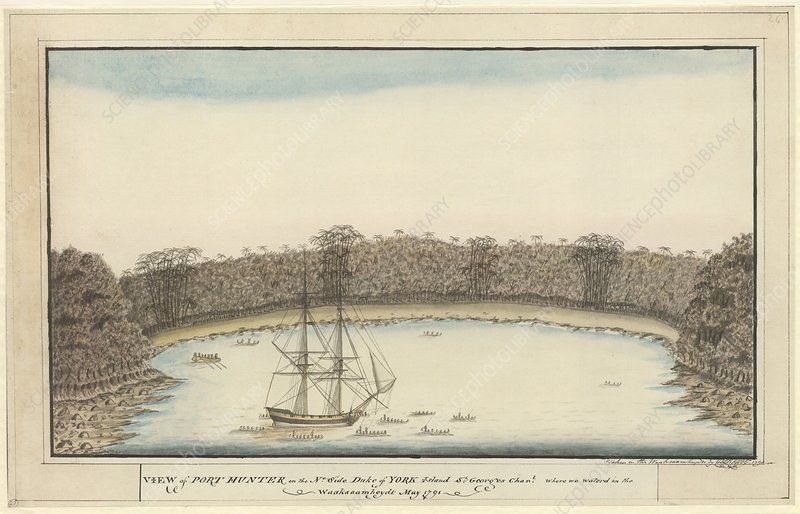
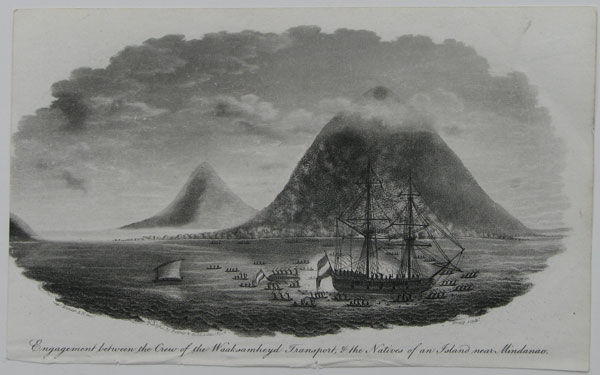
As written on the text sheet “a quarrel that took place between the natives of an island situated off the south point of Mindanao, and the crew of the Waaksamkeyd transport, on board of which were embarked the officers and company of his Majesty’s late ship Sirius. The vessel wore Dutch colours, because the natives were known to be in the interest of the Dutch, as appeared by the Rajah’s boat wearing the flag of that nation”. This engraving was published in the ‘Naval Chronicle’. Gold was the founder and publisher.
An interesting incident happened on the Waaksaamheyd on its voyage back to Europe.
| The Dutch master of this vessel gave convict William Bryant a compass, quadrant, charts and information on the sea route to Java. Soon after, Bryant, his wife Mary and other convicts made a daring escape in a fishing boat. They managed to sail all the way to Koepang in Timor, but their brave attempt was foiled when the Dutch authorities did not believe their claim to be shipwrecked mariners. |
See also:
After Cook landed on Australia’s east coast, severe casualties in Batavia – 1770
